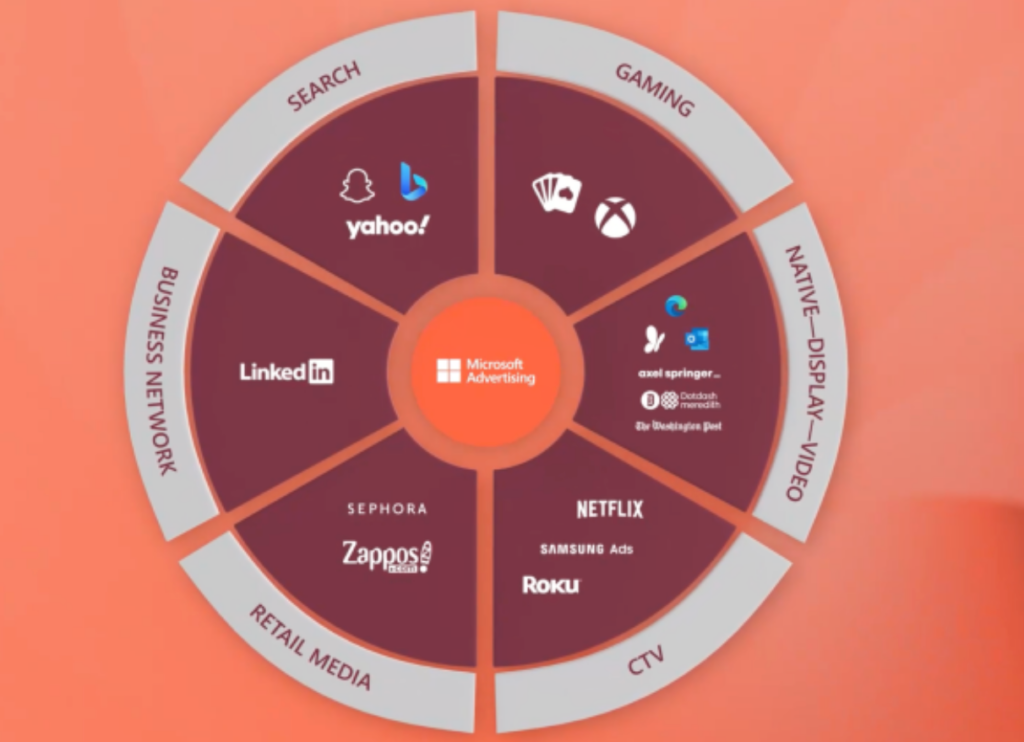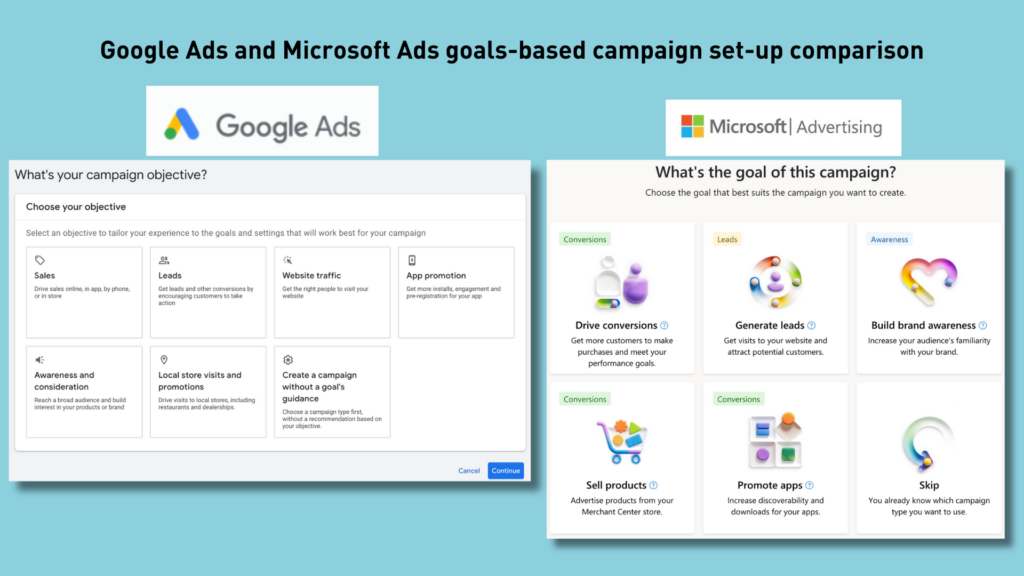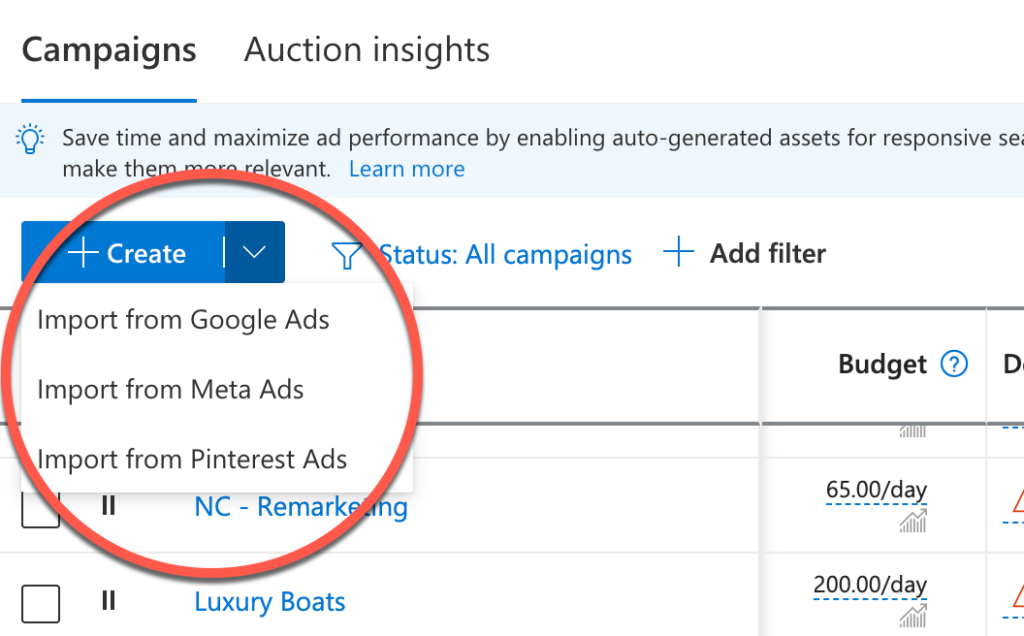Google Ads or Microsoft Ads?: Which Platform Wins for Your Advertising Goals?

When it comes to digital advertising, the opportunities are endless with Google Ads and Microsoft Ads. Both platforms offer exciting possibilities for reaching targeted audiences and driving conversions. Whether your goal is for broad exposure or niche targeting, each platform offers distinct advantages that can significantly boost your marketing efforts.
Google Ads at a Glance
Google Ads, launched in 2000, is the most popular ad network in online advertising. Its market share is massive, at over 90% of the search engine market share worldwide. Due to its extensive reach and features this ad platform tends to be the go-to default for advertisers of all sizes, from small local shops to large corporations. Users of Google Ads span all industries, but it’s particularly effective for reaching consumers.
Its integration with Google’s other services and properties, like YouTube, Gmail, Google Shopping, Google Maps, and Apps makes it a versatile ad platform for reaching diverse audiences. The broad user base and detailed targeting options make Google Ads a powerful choice for advertisers looking for search ads and a display network with partners sites across the Internet.
Microsoft Ads at a Glance
Microsoft Advertising launched back in 2006. While it doesn’t have the same massive market share of Google Ads, it still reaches millions of users through search on Bing, AOL, Yahoo, DuckDuckGo, Ecosia, and other search partners. The typical user demographic leans towards an older, more affluent crowd, with higher education levels. Advertisers are likely to reach decision-makers or a more mature audience with Microsoft Advertising. The platform also offers unique placements through its ecosystem of search, gaming, CTV, and more as seen in the image below. The integration with LinkedIn allows advertisers to target professionals, making it a great option for B2B advertisers looking to connect with a professional audience.

Screenshot by author Lisa Raehsler
Commonalities
Google Ads and Microsoft Advertising have much in common, making them both solid choices for digital marketers using a general purpose search and display platform.
1. Campaigns
Both platforms start by using a goal-focused approach to drive the campaign set-up. This means you can tailor your campaigns to suit different goals, whether it’s driving website traffic, generating leads, or increasing sales.

Comparison image created by author Lisa Raehsler
The campaign types offered by by each are very similar. This is helpful for planning, ad management, and analyzing results.
- Search campaigns
- Performance Max (PMax)
- Shopping
- Display/Audience
- Travel / Lodging
- Video
Google’s video campaigns focus on YouTube placements, with some access to Connected TV (CTV) ads via Google TV. Microsoft Ads also offers both online video placements and CTV campaigns for connected devices like smart TVs. These ads appear while users stream media on platforms through connected TVs or devices.
2.Targeting
Both Google and Microsoft provide advanced targeting options. This is often a key consideration when selecting an ad platform. You can reach audiences based on demographics, interests, and online behaviors, ensuring your ads get in front of the right people. People who have had interactions with your brand can also be re-engaged through retargeting across the search and display networks, using customer list match capabilities.
Let’s break it down! The following table lists the ad targeting options for Google Ads and Microsoft Ads, with a checkmark indicating which platform offers each option:
| Targeting Option | Google Ads | Microsoft Ads |
| Keyword Targeting | ✔️ | ✔️ |
| Demographic Targeting | ✔️ | ✔️ |
| – Age | ✔️ | ✔️ |
| – Gender | ✔️ | ✔️ |
| – Parental Status | ✔️ | ✔️ |
| – Household Income | ✔️ | ✔️ |
| Geographic Targeting | ✔️ | ✔️ |
| Radius Targeting | ✔️ | ✔️ |
| Device Targeting | ✔️ | ✔️ |
| – Desktop | ✔️ | ✔️ |
| – Mobile | ✔️ | ✔️ |
| – Tablet | ✔️ | ✔️ |
| Time/Day Targeting (Ad Scheduling) | ✔️ | ✔️ |
| Audience Targeting | ✔️ | ✔️ |
| – Remarketing/Retargeting | ✔️ | ✔️ |
| – Similar Audiences | ✔️ | ✔️ |
| – In-market Audiences | ✔️ | ✔️ |
| – Custom Audiences | ✔️ | ✔️ |
| Interest Targeting | ✔️ | ✔️ |
| Placement Targeting | ✔️ | ✔️ |
| Contextual Targeting | ✔️ | ✔️ |
| Topic Targeting | ✔️ | ✔️ |
| Language Targeting | ✔️ | ✔️ |
| Life Events Targeting | ✔️ | ❌ |
| Parental Status Targeting | ✔️ | ✔️ |
| Customer Match (Upload Customer Lists) | ✔️ | ✔️ |
| Lookalike/Similar Audiences | ✔️ | ✔️ |
| LinkedIn Profile Targeting | ❌ | ✔️ |
| – Company | ❌ | ✔️ |
| – Industry | ❌ | ✔️ |
| – Job Function | ❌ | ✔️ |
| Behavioral Targeting | ✔️ | ✔️ |
| Household Income Targeting | ✔️ | ✔️ |
| Custom Intent Audiences | ✔️ | ❌ |
| Affinity Audiences | ✔️ | ✔️ |
| Combined Audiences | ✔️ | ❌ |
| Sitelink Extensions Targeting | ✔️ | ✔️ |
Targeting options comparison table created by author Lisa Raehsler
Both Google Ads and Microsoft Ads offer a wide range of ad targeting options, with many similarities. However, there are two key differences in their unique features:
- Google Ads is able to tap into options like Life Events and Custom Intent Audiences, providing extensive reach and advanced audience segmentation.
- Microsoft Ads has the inside access to LinkedIn Profile Targeting, making it a unique option we will discuss later in this post.
3. AI for ads
Both Google and Microsoft ads employ AI and machine learning to create customized campaigns, optimize ad placements, and automate bidding strategies.
Microsoft’s AI tool, Copilot, is integrated into the Microsoft Ad platform to deliver AI features to directly benefit ads. AI-powered campaigns are also available in Google Ads, although the process to enable AI requires several steps. In a nutshell, both platforms’ AI tools seem to focus on ease of use and ad delivery benefits for advertisers:
- Enhanced Targeting: AI helps identify and target the most relevant audiences by analyzing vast amounts of user data points, ensuring ads reach those most likely to engage.
- Automated Bidding: Dynamically adjusts bids based on the likelihood of a click or conversion, maximizing your return on investment without needing manual optimizations.
- Ad Creative Optimization: Tests different ad creatives, such as headlines, images, and descriptions, to automatically determine and display the most effective combinations.
- Performance Insights: AI provides actionable insights and recommendations, to improve ad performance with less effort.
Unique features of each
Each platform offers unique and powerful features that will impress advertisers and can be incorporated into their PPC ads strategy. Let’s look at the most impactful:
Google Ads unique features
1. YouTube Ads Access
With Google Ads, you can run video campaigns on YouTube, the world’s largest video platform. This presents huge opportunities to engage audiences with skippable and non-skippable ads, something Microsoft Ads doesn’t offer. It’s not only great for advertisers with a focus on video, but also video ad newbies, since video ads often capture more attention and lead to higher engagement than text-based ads.
2. Life Events Targeting
Google Ads also lets you target people during major life events like getting married, graduating, or moving. This targeting feature can open up opportunities to make your ads more relevant and timely. For advertisers, this means reaching people when they’re making important decisions, increasing the chances of conversions when your product or services is highly connected to life events.
Microsoft Ads unique features
1. Netflix
A unique advantage to Microsoft Ads is exclusive accessibility to Netflix inventory. Advertisers can select to “Create a Video campaign that only serves on Netflix”.
2. LinkedIn
Another feature that sets Microsoft Advertising apart from Google is the integration with LinkedIn. Here’s how it works: Microsoft owns LinkedIn, so the two platforms are connected and able to share data. This means advertisers can tap into LinkedIn’s wealth of professional information from the Microsoft Ad platform. This allows advertisers to reach users based on professional information like company, industry, and job function.
This integration is valuable because it allows for incredibly precise B2B targeting and has the potential to give you the edge when you need to focus on specific professional attributes. If your business thrives on reaching certain job roles or industries, this feature can be a game-changer.
3. Campaign imports
Microsoft Advertising makes it easy to get started by allowing advertisers to import campaigns from a few key platforms, starting with Google Ads. If you already have campaigns running on Google Ads, you can seamlessly import them into Microsoft Advertising. This means expanding your reach without the hassle of recreating campaigns.
It gets better—Microsoft Advertising also supports imports from Facebook/Meta Ads allowing you to take advantage of the hard work you’ve already put into setting up and optimizing your campaigns elsewhere. Meta Ads campaigns will be imported to Microsoft Advertising as audience campaigns.
Pinterest Ads campaigns import was recently and these can be imported to Microsoft Advertising as audience campaigns. By importing your campaigns, you can quickly adapt to Microsoft’s audience, which often includes different search behaviors and demographics than Google or Facebook. This way, you can fine-tune your strategies to fit the unique strengths of each platform without duplicating your workload.

Screenshot created by author Lisa Raehsler
4. Search partner reporting
Another advantageous element of Microsoft ads is the transparency into the search partners network, with the way it reports on website URLs and performance data. This can help inform advertisers to make better decisions on the part of the managing search partner placements for their ads. Google only allows search partner placements to be turned on or off.
5. Ad Group level settings
Lastly, Microsoft Ads offers the ability to schedule ads and target locations at the ad group level. Google offers only campaign level, making this a key factor in how accounts are structured and budgets allocated.
Summary
Google Ads and Microsoft Ads are both powerful platforms, each with unique strengths. Google Ads offers a broader reach with its massive user base, making it ideal for campaigns that need extensive visibility. It excels in demographic and behavioral targeting, ensuring ads reach relevant audiences across Google’s network. Microsoft Ads, on the other hand, stands out with its LinkedIn integration, making it a great choice for B2B marketing. Both platforms leverage AI for automated bidding, creative optimization, and performance insights, but Google’s larger audience gives it an edge in overall reach and volume.
Overall, the best platform for you may depend on your specific goals, budget, and target audience. Many advertisers find success using both platforms to maximize their digital advertising efforts.



